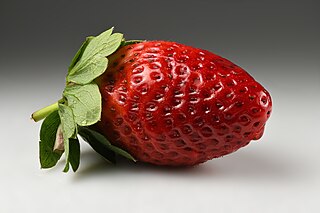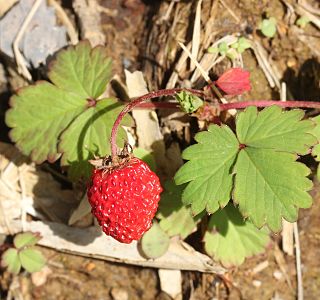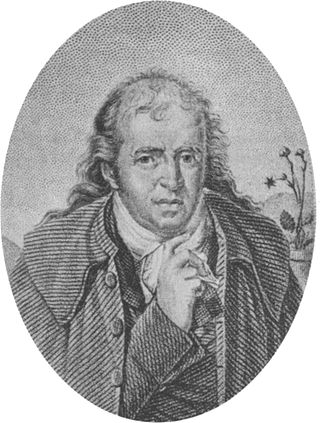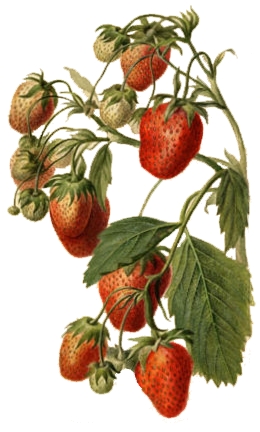
A berry is a small, pulpy, and often edible fruit. Typically, berries are juicy, rounded, brightly colored, sweet, sour or tart, and do not have a stone or pit, although many pips or seeds may be present. Common examples of berries in the culinary sense are strawberries, raspberries, blueberries, blackberries, white currants, blackcurrants, and redcurrants. In Britain, soft fruit is a horticultural term for such fruits.

Fragaria is a genus of flowering plants in the rose family, Rosaceae, commonly known as strawberries for their edible fruits. There are more than 20 described species and many hybrids and cultivars. The most common strawberries grown commercially are cultivars of the garden strawberry, a hybrid known as Fragaria × ananassa. Strawberries have a taste that varies by cultivar, and ranges from quite sweet to rather tart. Strawberries are an important commercial fruit crop, widely grown in all temperate regions of the world.

The garden strawberry is a widely grown hybrid species of the genus Fragaria, collectively known as the strawberries, which are cultivated worldwide for their fruit. The fruit is widely appreciated for its characteristic aroma, bright red color, juicy texture, and sweetness. It is consumed in large quantities, either fresh or in such prepared foods as jam, juice, pies, ice cream, milkshakes, and chocolates. Artificial strawberry flavorings and aromas are also widely used in products such as candy, soap, lip gloss, perfume, and many others.

Fragaria virginiana, known as Virginia strawberry, wild strawberry, common strawberry, or mountain strawberry, is a North American strawberry that grows across much of the United States and southern Canada. It is one of the two species of wild strawberry that were hybridized to create the modern domesticated garden strawberry.

The musk strawberry or hautbois strawberry, is a species of strawberry native to Europe. Its French name hautbois strawberry may be anglicised as hautboy strawberry. The plants are hardy and can survive in many weather conditions. They are cultivated commercially on a small scale, particularly in Italy. The fruit are small and round; they are used in the gourmet community for their intense aroma and flavour, which has been compared to a mixture of regular strawberry, raspberry and pineapple. Popular cultivated varieties include 'Capron' and 'Profumata di Tortona'.

Fragaria vesca, commonly called the wild strawberry, woodland strawberry, Alpine strawberry, Carpathian strawberry or European strawberry, is a perennial herbaceous plant in the rose family that grows naturally throughout much of the Northern Hemisphere, and that produces edible fruits.

Fragaria × vescana is a hybrid strawberry cultivar that was created in an effort to combine the best traits of the garden strawberry, which has large berries and vigorous plants, with the woodland strawberry, which has an exquisite flavour, but small berries.

Fragaria chiloensis, the beach strawberry, Chilean strawberry, or coastal strawberry, is one of two species of wild strawberry that were hybridized to create the modern garden strawberry. It is native to the Pacific Ocean coasts of North and South America.

Fragaria iinumae is a species of strawberry native to Japan and eastern Russia.

Fragaria viridis, commonly called creamy strawberry or green strawberry is a species of strawberry native to Europe and central Asia. It has fruits with fine flavour. They have surprisingly little of the usual strawberry aroma, but a refreshing acidity, and sometimes ripen without becoming red. When they are plucked from the plant, the calyx will usually adhere and they will detach with a noticeable snapping sound.

Fragaria moupinensis is a species of wild strawberry native to China. It is similar in appearance to F. nilgerrensis.

Fragaria nilgerrensis is a species of flowering plant in the family Rosaceae. It is a wild strawberry native to southern and southeast Asia. Its fruit are white to light pink, with poor flavour, and the fruit is of no commercial value. It is similar in appearance to F. moupinensis.

Fragaria nubicola is a species of wild strawberry native to the Himalayas. It is of no commercial value.

George McMillan Darrow (1889–1983) was an American horticulturist and the foremost authority on strawberries. He worked for the United States Department of Agriculture (USDA-ARS) for forty-six years as the pomologist in charge of research on deciduous fruit production, and authored a multitude of papers on planting and cultivating small fruits.

The Marshall strawberry is a cultivated variety of Fragaria ananassa, that is known for an "exceptional" taste and had been described as "the finest eating strawberry" in America.
Fragaria × bringhurstii is a naturally occurring hybrid species of wild strawberry native to the West Coast of the United States. The species results from the natural intercrossing of Fragaria vesca and Fragaria chiloensis, native species whose ranges overlap in that region.

Antoine Nicolas Duchesne was a French botanist known for his keen observation of variation within species, and for demonstrating that species are not immutable, because mutations can occur. "As Duchesne's observations were unaided by knowledge of modern concepts of genetics and molecular biology, his insight was truly remarkable." His particular interests were in strawberries and gourds.

The breeding of strawberries started with the selection and cultivation of European strawberry species in western Europe in the 15th century while a similar discovery and cultivation occurred in Chile. The most commonly consumed strawberry species in modern times is the garden strawberry, a species derived from hybridization of two other species, with the scientific name Fragaria × ananassa, but there are many species of strawberries, several others of which are cultivated to some extent. The strawberry species fall into several different genetic types, based on their number of chromosomes. Strawberry growers have employed many breeding techniques, starting with traditional plant breeding and then moving on to molecular breeding and genetic engineering in the 20th century.

D. Vivian Lee Bowden was a science journalist who discovered the unpublished drawings of early French botanist Antoine Nicolas Duchesne and authored an influential history of the garden strawberry. Her extensive research conducted in both Europe and America has been widely cited.



















